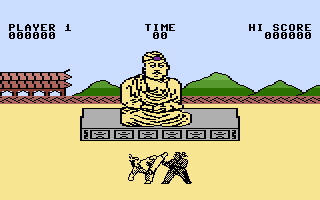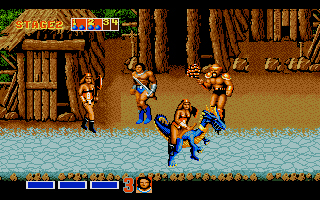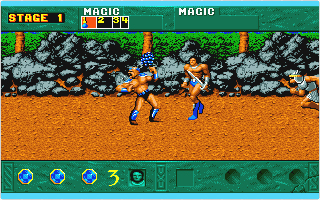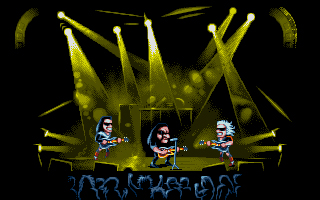

Richard Costello interview
By Ross Sillifant
(2016)
Q: Could you please introduce yourself and give a little background info on what you've worked on, for the benefit of our readers?
Richard Costello: Hi, I am Richard Costello. I used to program computer games for a living, and then I used the money I earned to go motor racing and now I am a motor racing instructor, but I keep my hand in with web development on a small scale and mess about with
 low-level code. After leaving college, I initially worked at Loughborough University with Paul Carruthers writing software on the BBC Micro, and helped write XOR Designer (mask title screen and file management bits were mine - basically
the shell) before creating Way of the Exploding Fist on the Commodore C16. I left Loughborough to work for Gremlin Graphics in Birmingham to code on the Atari ST. I created an unreleased game called RamRod and in my spare time coded Gauntlet II on ST and Amiga. I also assisted with MASK on the C64. I then left Gremlin and went freelance, working with Kev Bulmer initially on Golden Axe, Hotrod, and Terminator 2, and
then independently for Virgin on MotŲrhead (all on ST & Amiga). I worked with Paul again on Megadrive MK1 but my final games were all Amiga only for Probe including Mortal Kombat 1 & 2 and Primal Rage. I stopped coding games when the Playstation arrived. I have also developed stuff for the Psion Organiser.
low-level code. After leaving college, I initially worked at Loughborough University with Paul Carruthers writing software on the BBC Micro, and helped write XOR Designer (mask title screen and file management bits were mine - basically
the shell) before creating Way of the Exploding Fist on the Commodore C16. I left Loughborough to work for Gremlin Graphics in Birmingham to code on the Atari ST. I created an unreleased game called RamRod and in my spare time coded Gauntlet II on ST and Amiga. I also assisted with MASK on the C64. I then left Gremlin and went freelance, working with Kev Bulmer initially on Golden Axe, Hotrod, and Terminator 2, and
then independently for Virgin on MotŲrhead (all on ST & Amiga). I worked with Paul again on Megadrive MK1 but my final games were all Amiga only for Probe including Mortal Kombat 1 & 2 and Primal Rage. I stopped coding games when the Playstation arrived. I have also developed stuff for the Psion Organiser.
Q: I'm going to focus on your time with the Atari ST if that's ok. So to start with, I simply have to ask about the stunning-looking Ramrod (Gremlin Graphics). Previews in the likes of Zero, The One, and Zzap64 made it out to look like a cross between Robocop and Marble Madness, so any information you could share with us regarding it (how far along from concept it reached, why it was canned, what differences there would of been between the ST and Amiga versions, etc) would be most welcome.
Richard Costello: RamRod was finished on the ST but it had no depth and the gameplay was rubbish. Robocop meets Marble Madness is a perfect description. It was very heavy on graphics, which as you mentioned were gorgeous (all by Kev Bulmer R.I.P.). They were the best bit. But the game
just consisted of the main character wandering about 3 levels each 4 screens high (vertically-scrolling) and on each level playing 4 arcade games-within-a-game where RamRod was scanned into the arcade machine (like in TRON) where he became the central character in Space Invaders, etc. The arcade games were added in an effort to add gameplay. The whole project was a bit of a dinosaur with no central control, management, or direction unfortunately (I was no game designer
- I enjoyed writing cool code), and I was left to come up with the game I guess, so all it became was a lump of cool code displaying cool graphics; bit of a demo I guess. I recently found my ST "master" discs so I am trying to get them working (my ST is dead at the moment and the format of them means they canít be read on a PC).
I also created an Amiga version, but I can only find a copy of Disc A, and it asks for Disc B! I have all the source code (I keep everything) so I could in theory create another master but have no time. The Amiga version would have been slightly faster than the ST version thanks to the blitter, and the colours may have been slightly better, although still 16 colour as there was only one set of graphics.
Q: If my information is correct, youíve been quoted as saying you felt the Atari ST wasn't powerful enough for conversions of both Mortal Kombat and Primal Rage. Could you explain a little about why you felt that way, and did you ever see the conversions of MK to the Sega Game Gear and Nintendo GameBoy, and also Primal Rage to Gameboy, Game Gear, and Sega Master System (all 8 bit systems), and think a compromised version could have been possible on the ST?
Richard Costello: I never saw the conversions you mention. Obviously an 8-bit styled version could have been produced for the ST but people would have expected something similar to the Amiga version which would not have been possible for two reasons: only 16 colours and no blitter. On the Amiga
the backgrounds and panel graphics plus blood used 16 colours, and then the fighters used 8 colours each. Imagine the ST version with 8 colours for the backgrounds and 4 colours each for the fighters. The blitter in the Amiga was used to good effect to clean the screen of previous animations and to cookie-cut each fighter onto the screen along with generating the player shadows.
In general the game ran 2 to 4 frames per game loop - the ST would have been very slow and unplayable. Primal Rage needed 2MB on the Amiga, too. Commercially the ST was dying by the time MKI & II were launched so less and less was being written for it and the economics meant ST games tended to be ports of the Amiga version as there wasnít enough money in it to develop a separate version for the ST, and as mentioned above people would have slayed it if it was much weaker than the
Amiga version, which it would have been.
Q: Were you like many a coder of that era, not wishing to make compromised to your work, whenever and where ever possible?
Richard Costello: It was work, so it needed to always be economically viable. That was the bottom line.


Golden Axe for the Amiga (LEFT) and Atari ST (RIGHT)
Q: You worked on a number of high-profile arcade conversions to the ST including Gauntlet II, Golden Axe, and Hot Rod. Given the ST's lack of custom hardware (such as no blitter, hardware sprites, limited colours, and weak sound chip), I wonder A) how much of a mountain you had to climb, and B) if you had wished Atari had introduced the STE years earlier?
Richard Costello: Atari should have introduced the Amiga when they had the chance. The ST was a panic reaction they had when they realized they had lost the Amiga and needed a 16-bit machine. The Amiga was a natural progression from the 8-bit Atari architecture, given it was created by the same
team of people. The ST was a nice general-purpose computer which Atari should have developed into the PC by licensing the architecture out - that would have lead to Motorola being Intel today and Atari would be massive, too. But they didnít; instead, they reacted too slowly and then tried to develop custom games machines to make up for it but time ran out, and the Playstation arrived, bringing in a BIG hardware and programming shift from low-level code 2-D to higher-level code 3-D
and that was that. Atari started dying when Jay Miner left them.
Plus, both Commodore and Atari stood still with 16-bit. Acorn had the right idea by going straight to true 32-bit and whilst Acorn didnít survive, their processor obviously did.
Q: Speaking of the ST hardware, how did you personally rate the range (ST to STE) and Atari's handling of their constant upgrades to compete with what Commodore were doing?
Richard Costello: As mentioned above, it was too little, too late. They should not have been trying to compete with Commodore; they should have continued on the ďserious computerĒ path.
Q: Did you ever work on platforms like the Lynx, Falcon, or Panther?
Richard Costello: No, they sold in too low volumes in the UK to be a serious platform.
 Q: I have to ask about your work on the ST/Amiga game, MotŲrhead, which was based around the
band. Many at the time thought it an obscure source to base a game around. Did the legendary Lemmy (RIP) have any input on the game? The game itself seemed a bit too demanding for the ST, suffering from slowdown and jerky scrolling. Was this hardware-related or were there other issues?
Q: I have to ask about your work on the ST/Amiga game, MotŲrhead, which was based around the
band. Many at the time thought it an obscure source to base a game around. Did the legendary Lemmy (RIP) have any input on the game? The game itself seemed a bit too demanding for the ST, suffering from slowdown and jerky scrolling. Was this hardware-related or were there other issues?
Richard Costello: Motorhead was Golden Axe - it used the same game engine. I donít recall it being much slower than Golden Axe, but maybe there were more sprites onscreen which may have affected frame rate. I didnít meet with Lemmy but the producer I worked with at Virgin did meet him in his local pub a couple of times.
Q: Both Napalm Nigel and Rapido are ST unknowns to me, so any information on them would be most welcome :-)
Richard Costello: Napalm Nigel was a single-screen of graphics by Kev and a bit of Gauntlet II code - nothing ever came of it as we left Gremlin. There was no animation or game design as such. Nigel looked like Tin Tin. Rapido was a development system, a cross-platform assembler for Psion Organiser development on an ST. I am currently trying to convert it to work in a browser window and remotely develop a Raspberry Pi.
Q: To this day, there remains an element that retains the idea the ST maintained a strong market presence in the UK - along with good publisher support - by the time Atari launched the Jaguar console (not a view I subscribe too, personally), so when did you feel it was evident Atari had lost the battle and the ST was in a state of rapid decline?
Richard Costello: Once the Amiga appeared, the ST started to die. Initially games were being written for the ST and were ported to the Amiga, which was sustainable, given the Amiga was more powerful. But once games were developed for the Amiga and took advantage of its hardware, the ST required
its own version, which doubled the costs. The ST game sales then began to slump and that was that.
When I wrote Mortal Kombat on the Amiga, there was no ST development happening at Probe that I recall. It was all Nintendo and Sega by then. Atari lasted a bit longer in a commercial sense with their specialist business (music and some business use), but I donít know why Ė people should have been using Acorn machines by then until the PC landed in full force with Windows 95. Itís a shame because the 68000 was a MUCH nicer processor than the Intel offerings, but then they all
got kicked into touch by ARM.
Q: Any other lost games (any format) you can tell us about?
Richard Costello: No, the only ghost in the cupboard is RamRod - I am working on at least getting a video of it out, in memory of Kev Bulmer. Kev rang me a few years ago because a magazine was looking to do articles on unreleased games and they wanted to start with RamRod. So we were going to try to cobble something together. I got busy and Kev went quiet. It was a couple of years later when Kevís partner informed me he had passed away. He was a fantastic artist.
Q: Any other 'claims to fame' outside of the games industry?
Richard Costello: I coached Jenson Button when he started racing and have qualified and finished in front of Jan Magnussen (Kevinís Dad), which I am pleased with, but I ran out of cash when racing. It has that effect :-)
Q: Finally, any messages for your fans? What are you up to these days?
Richard Costello: I would like to thank everyone who has posted videos of games I created on YouTube. I really get a kick out of watching them every now and again. I still have all the boxed originals on the shelf, and I still have my BBC Micro, Amiga A600, and Mega 4 ST (PSU dead), but the
videos are cool. I will try to get RamRod on there, too.
As mentioned above, I instruct on racing circuits nowadays and I also do some graphic design and web development. I am interested in programming ARM code direct to metal on the Raspberry Pi. I really wanted to work with the ARM processor back in the day and I really dislike high-level languages, but I am doing it for fun more than anything. If I had stayed on at University instead of getting into programming games when I left college then I imagine I would have ended up at
Acorn and then ARM or Broadcom, looking back at things.
There is a magazine review of Primal Rage that has an old photo of me with my integrale (car); I still have it and have recently disassembled its engine management ECU to see how it works (it's got an 8-bit Motorola 6803 processor in it), so that got me back into cool code again and keeping my hand in good old direct-to-metal development.
I have quite a lot of jobs and do all sorts of things - nothing to do with computer games, though. I didnít like programming in C over Assembler and preferred working alone rather than as a small cog in a big machine. Games have become business software, rather than engineering tasks.
I have contributed a few quotes to the soon-to-be-released Gremlin Graphics book, which sounds like it will be a good read.
Been a pleasure reminiscing.